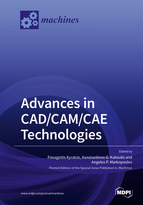Advances in CAD/CAM/CAE Technologies
A special issue of Machines (ISSN 2075-1702).
Deadline for manuscript submissions: closed (31 March 2019) | Viewed by 37870
Special Issue Editors
Interests: CAD-based manufacturing; CAD/CAM/CAE; manufacturing and machining; product and packaging design; reverse engineering and prototyping
Special Issues, Collections and Topics in MDPI journals
Interests: CAD; algorithm engineering; computational geometry; CAD-based applications
Interests: manufacturing technology; machining processes; non-conventional machining; modeling and simulation
Special Issues, Collections and Topics in MDPI journals
Special Issue Information
Dear Colleagues,
CAD/CAM/CAE technologies are finding more and more applications in today’s industry, i.e. in the automotive, aerospace and naval sectors. CAD-based applications have taken advantage of the application programming interface (API) available within the CAD/CAM/CAE systems and to move these research activities to a higher level. A number of difficult-to-perform manufacturing processes can be simulated using more methodologies available via advanced integrated CAD systems.
CAM technology has expanded beyond the creation of the appropriate CNC code needed for manufacturing unusual geometries with multi-axis machining centers. The trajectory optimization and time needed for manufacturing improvements have become extremely important issues.
CAE technologies deal with a number of simulations i.e. linear/nonlinear finite elements analyses, multi body dynamics and reverse engineering. The tools available become have more sophisticated and the engineers/researchers consider this challenge as an opportunity for more accurate simulations.
This Special Issue provides an opportunity for researchers to present recent advances and technologies in the aforementioned fields and indicate the future trends for CAD/CAM/CAE technologies.
Suitable topics for this Special Issue include, but are not limited to:
- CAD based applications
- CAD/CAM systems
- Finite element simulations
- Machining and manufacturing applications
- CAM optimization methodologies
- Design simulations
- Computational design
- Graphics algorithms
- Geometric modeling
- Reverse engineering
- Prototyping
- Robotics
- Medical/biomedical applications
- CMM applications
- Automotive applications
- Aerospace applications
Prof. Dr. Panagiotis Kyratsis
Prof. Dr. Konstantinos Kakoulis
Prof. Dr. Angelos P. Markopoulos
Guest Editors
Manuscript Submission Information
Manuscripts should be submitted online at www.mdpi.com by registering and logging in to this website. Once you are registered, click here to go to the submission form. Manuscripts can be submitted until the deadline. All submissions that pass pre-check are peer-reviewed. Accepted papers will be published continuously in the journal (as soon as accepted) and will be listed together on the special issue website. Research articles, review articles as well as short communications are invited. For planned papers, a title and short abstract (about 100 words) can be sent to the Editorial Office for announcement on this website.
Submitted manuscripts should not have been published previously, nor be under consideration for publication elsewhere (except conference proceedings papers). All manuscripts are thoroughly refereed through a single-blind peer-review process. A guide for authors and other relevant information for submission of manuscripts is available on the Instructions for Authors page. Machines is an international peer-reviewed open access monthly journal published by MDPI.
Please visit the Instructions for Authors page before submitting a manuscript. The Article Processing Charge (APC) for publication in this open access journal is 2400 CHF (Swiss Francs). Submitted papers should be well formatted and use good English. Authors may use MDPI's English editing service prior to publication or during author revisions.








